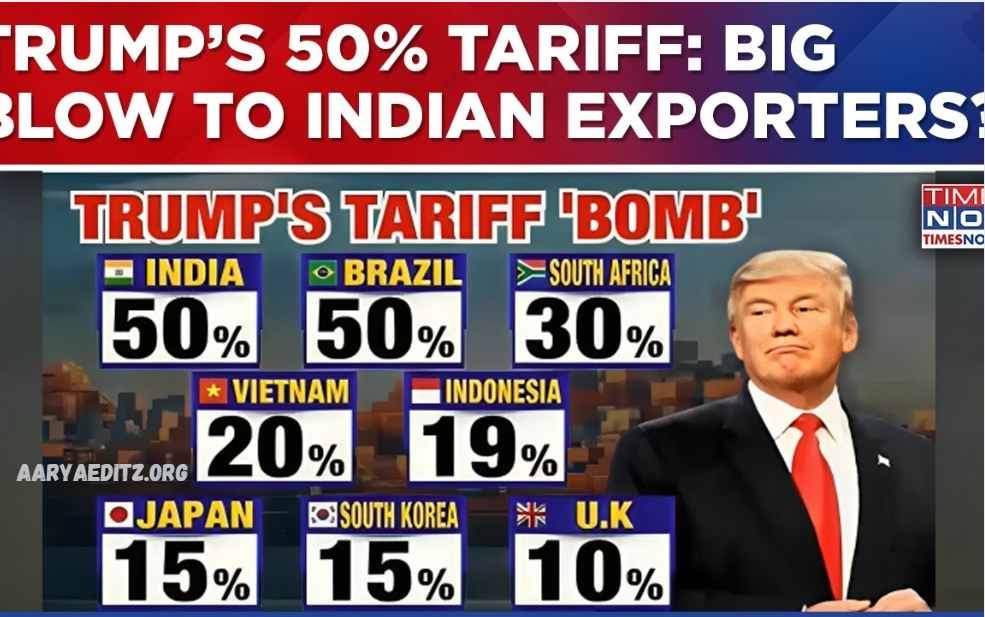Indian exporters have raised concerns over the Trump administration’s recent 50% tariff on certain goods. They see this increase as a setback for businesses that have worked to build strong US trade ties. Exporters warn that the tariff will raise costs, threaten the competitiveness of Indian products, and may lead to reduced demand and lost opportunities.
This move comes as Indian exporters face economic uncertainty and rising competition. Many businesses rely on the US for textiles, chemicals, and other goods. With tariffs doubling, Indian exports become more expensive and less attractive compared to others.
Industry leaders urge governments to engage in dialogue and find solutions that support fair trade and protect exporters. They note that high tariffs could disrupt supply chains, affect jobs, and slow growth. The Indian government is expected to respond diplomatically to mitigate the impact of the situation.
Indian Exporters Hit Hard by New 50% US Tariff
Indian exporters face a challenge following the US’s introduction of a 50% tariff. The sudden rise caught many businesses off guard, sharply raising export costs to India’s major trade partner. Textiles, chemicals, and manufactured items are particularly affected, reducing their competitiveness in the US.
The higher tariff means exporters must either absorb the costs or pass them on to buyers, which could reduce demand. Smaller businesses, with thin profit margins, are especially vulnerable. Exporters worry that this move could lead to a decline in sales, delays in shipments, and job losses.
Industry associations urge swift government action to help affected exporters. They hope for a diplomatic solution to ease tensions and restore balanced trade.
How the Tariff Affects India’s Key Export Sectors
The new 50% US tariff broadly impacts key Indian export sectors. Industries such as textiles, chemicals, pharmaceuticals, and engineering face higher costs and reduced competitiveness.
The textile sector, a major employer, is hit hard. Higher tariffs make Indian fabrics and garments costlier for Americans, reducing their competitiveness and threatening workers’ livelihoods.
The chemical and pharmaceutical industries now see higher US prices for their products. These vital sectors may face slower growth and a decline in global market share due to increased costs.
Business Leaders Speak Out Against Steep Tariffs
Indian business leaders strongly criticize the US tariff, calling it a blow to the export-driven economy. Many consider the steep hike unfair and harmful, especially as global markets remain uncertain.
Industry representatives warn that high tariffs increase the costs of Indian products, making them less attractive to US buyers. This could sharply drop orders, hurting companies of all sizes, especially those reliant on exports.
Many business leaders urge the government to act diplomatically. They stress the need for US dialogue to find a fair solution that protects Indian exporters.
Impact on India-US Trade Relations and Future Outlook
The US’s 50% tariff marks a tense phase in trade ties. It raises concerns about the potential for escalating trade barriers between the two countries, given their growing economic relations.
The steep tariff could strain diplomatic relations, as India views it as protectionist, targeting its exporters. Indian officials are likely to seek negotiations to mitigate the impact and restore a balanced trade environment. However, if tensions continue, there is a risk of further retaliatory actions that could affect multiple industries.
Future India-US trade depends on how disputes are handled. Successful talks may ease tariffs and build cooperation, benefiting both countries. Prolonged conflict could slow trade and add uncertainty for exporters.
Government Response and Possible Solutions
The Indian government has responded quickly, recognizing the serious impact. Officials express concern and are engaging with their US counterparts to seek tariff reduction or removal through diplomatic channels.
To support affected exporters, the government is considering measures such as export incentives, compensation, easing tax burdens, and improving credit access for those experiencing cash flow issues.
The government encourages exporters to diversify beyond the US, targeting Europe, Southeast Asia, and Africa. Expanding new markets can reduce dependence and guard against similar shocks.
Frequently Asked Questions
How is the Indian government responding?
India is engaging in diplomatic talks with the US and considering financial support and incentives for affected exporters.
Can Indian exporters avoid tariffs by modifying their products?
Some exporters may adapt their product lines, but many face limited options and require broader market strategies.
Will this tariff affect prices for American consumers?
Yes, higher tariffs may lead to increased prices for imported Indian goods in the US.
Are there other markets Indian exporters can explore?
Yes, markets in Europe, Southeast Asia, and Africa are being encouraged as alternatives.
What is the long-term outlook for India-US trade relations?
While the tariff is a setback, both countries have strong reasons to resolve disputes and maintain healthy trade ties over time.
Conclusion
The 50% US tariff poses a major challenge for Indian exporters, threatening key industries and bilateral trade growth. The immediate impact highlights the need for more government support and market diversification.

